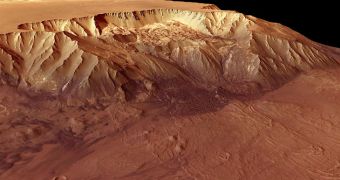By analyzing data beamed back by the Mars Express spacecraft, researchers have finally been able to piece together a detailed history and description of the lowest-lying place on Mars.
The floor of canyon-like landscape feature known as Melas Chasma is estimated to lie about 9 kilometers underneath the level of the surrounding planes.
For comparison, the deepest place on Earth, the Mariana Trench has a depth of 11.03 kilometers (6.85 miles). In other words, Melas Chasma could easily fit Mount Everest within, with room to spare.
Given its size, researchers approximated that this enormous Martian canyon would have a very complex and rich history, which is one of the main reasons why the European space probe was trained on it.
From a broader point of view, the area lies within the huge Valles Marineris rift valley, experts at the European Space Agency (ESA) report.
The valley covers an area more than 4000 kilometers long, across the surface of Mars. The image attached to this article only covers a 200 x 100 kilometer area of that spread.
These 20,000 square kilometers are comparable to the size of Slovenia. What makes the region is important is the fact that evidence lying all over the place suggest that liquid water flowed there in the past.
Some of these evidence include the presence of lighter-colored deposits of sulphate components at the canyon, as well as the discovery of ancient channels, which were most likely cut by flowing water.
The sulphate deposits, ESA believes, were gathered at a site where an ancient lake bed used to lie. This would go a long way towards explaining the minerals.
In order to get the best possible views of the area, experts turned to the High-Resolution Stereo Camera (HRSC) instrument abord Mars Express.
“The valley sides show evidence of multiple large landslides that have created vast fan shapes of material,” ESA experts write in a statement.
“This debris appears rough and jumbled, contrasting with the underlying smoother surface visible further into the basin,” the document reads.
“The rocks display flow textures indicating that they were once deposited by liquid water, water ice or mud. Levees of sediment can also been seen here,” they add.
Studies of the Mars Express images also revealed the existence of former fault lines, which run parallel to the direction of the canyon.
This may help explain the instability of the terrain, which oftentimes changes its configuration in massive landslides.

 14 DAY TRIAL //
14 DAY TRIAL //